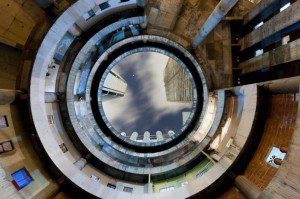Review: ‘Constructing Worlds’

Felicity Barbur | 02 January 2015
Presenting Constructing Worlds: Photography and Architecture in the Modern Age at the Barbican in London always seemed likely to prove a good choice of venue. However, it wasn’t until visiting the carefully curated spaces of each photographer that I appreciated just how appropriate the Chamberlin, Powell and Bon designed complex would prove to be. After all, over the years the Barbican itself has been captured from many angles by many different photographers, creating images that have often served to influence our perceptions of the success and failure of what former Guardian architecture critic Jonathan Glancey called a ‘concentration of concrete monuments’.
Curated by Alona Pardo and Elis Redstone, Constructing Worlds brings together eighteen exceptional photographers from the 1930s up to the present day, who have ‘changed the way we view architecture and perceive the world around us’. From churches and skyscrapers to dams and bridges and onto parking lots and war zones, one feels compelled to appreciate the city and modernity as shaped by the photographer who has reproduced it.
To ‘reveal hidden truths in our society’ the curators have laid bare each of the various techniques that the photographers used to empower their photography and the architectural worlds that they were immersed in. Japanese artist Hiroshi Sugimoto, for example, uses the ‘twice infinity’ technique to distort the reality of the construction in order to distil the core vision of the building. Julian Shulman’s method was to resourcefully place objects and people in order to depict the ‘ideal of Californian living’. The dramatization used by Lucien Herve to capture Le Corbuiser’s work is in stark concept in contrast to Thomas Sturth’s scientific placement of the camera in the same place to realise a more comparative structure of streetscapes.
While the majority of photographs focus on the built forms, they nevertheless encourage the viewer to assess how the evolution of architecture has impacted on the lives of inhabitants. From the vantage point of the West in the 21st century, it can be easy to forget the times when the condition of cities remained immature and developers were faced with navigating a path through advances in construction techniques and new technologies. These 250 works of photography portray how changes in architecture and urban form in turn influence the evolution of human societies around the world. Advances enable separate evolving processes to take place. Many lead to fulfilment of human needs, others which impose hardship; such is the nature of progress. An exhibition such as this captures the depth and experiential quality of architecture of different times across the century, forming a record of how we evolve and most importantly how we see and judge our evolution.
It is at this point I recalled the point in Kevin Lynch’s book The Image of the City where he states that image development is a two way interaction between the observer and the observed. The imagebility of an object is based on three components: structure, meaning and identity, and these components yield a strong sense of legibility that makes a building a visually recognisable entity. In Constructing Worlds the photographers have soaked their images in memories that are unique to an individual and such representation prompts us to be critical of what is depicted. It is easy to forget that the photographs we are looking at are not the finished product, but actually are playing a part of the process of establishing an image of the constructed world. The way we see our evolution changes and therefore carefully conceived images in one era can become iconic and alter the true perception in another. This exhibition is an important reminder that history is never settled but continually recreated in line with the present.
Constructing Worlds: Photography and Architecture in the Modern Age
Barbican Art Gallery, Barbican Centre, UK. 25 September 2014 – 11 January 2015
Felicity Barbur has worked and lived in Holland and Japan. She is a Part II architectural assistant studying for her Masters at The Bartlett School of Architecture.






